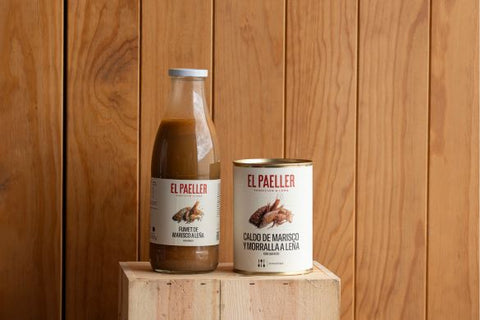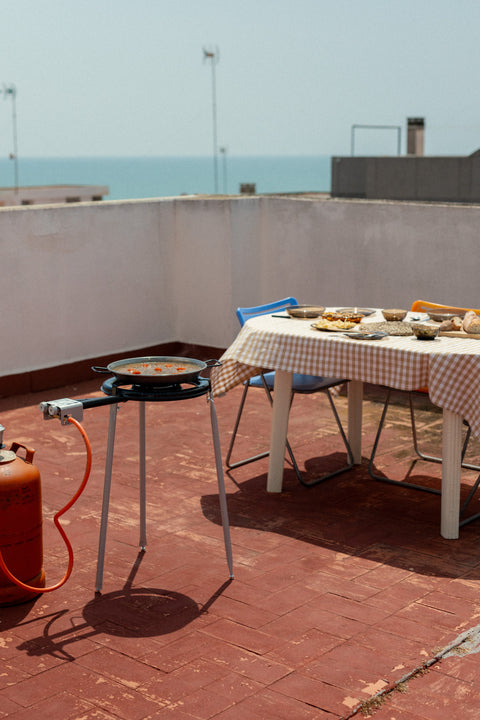Fish stock and fumet are two fundamental culinary preparations in Mediterranean cuisineespecially in the preparation of seafood dishes like paella. And although at first glance they may seem similar, there are subtle but important differences between the two.
Therefore, we will now explore the distinctive characteristics of each one, learn how to prepare them, and discover when it is most appropriate to use each one in our recipes.
?What is fumet??
Fumet is a concentrated and aromatic broth made primarily made with scraps of white fish. This stock is characterized by its intense and refined flavor, the result of a careful selection of ingredients and a specific preparation method.
And unlike ordinary fish stock, the fish fumet It is cooked for a shorter time, generally no more than 30 minutes, to prevent the flavors from becoming too strong or bitter. This technique allows the most delicate flavors of the fish and vegetables to be extracted, creating a perfect base for sauces, soups, and rice dishes.

Main characteristics of fumet
Concentrated flavor
He fish fumet It is distinguished by its intense and concentrated flavor. This is because, by using mainly bones and heads of white fish, along with a careful selection of vegetables, a broth with a complex and refined flavor profile is achieved.
Lightweight texture
Despite its concentrated flavor, fumet maintains a light and clear texture. This is because it is carefully strained, removing any impurities during the cooking process, resulting in a clean and transparent liquid.
Culinary versatility
Fish stock is incredibly versatile in the kitchen. It can be used as a base for sauces, soups, seafood risottos, and, of course, to prepare an exquisite seafood paella. Its powerful yet balanced flavor perfectly complements the seafood ingredients without overpowering them.
?How to make fish stock for paella?
Step 1. Ingredient Selection
For make a fish fumet Perfect for paella, start by selecting quality white fish such as hake, monkfish, or sea bream. Use the bones, heads, and trimmings, making sure to clean them thoroughly and remove any traces of blood or viscera.
Step 2. Preparing vegetables
Next, finely chop the onion, leek, carrot, and celery. These vegetables will add flavor and aroma to the stock. Optionally, you can add a little fennel for a subtle aniseed note.
Step 3. Cooking
In a large pot, sauté the vegetables in olive oil until translucent. Add the fish scraps and cover with cold water. Bring to a boil, then reduce the heat and simmer for 20-30 minutes, skimming off any foam that rises to the surface.
Step 4. Filtering and preservation
Once the broth has finished cooking, strain it through a fine-mesh sieve, pressing the solids well to extract all the juice. Then, let it cool to room temperature and refrigerate until ready to use, or freeze it in portions.

Main characteristics of fish broth
Milder flavor
Traditional fish stock has a milder and less concentrated flavor than fish fumetThis is because generally It cooks for a longer time and it can include a wider variety of fish, not just white fish.
Larger volume
By cooking for a longer time and with more water, fish stock typically produces a larger volume of liquid. This makes it ideal for recipes that require a considerable amount of stock, such as soups or fish stews.
Versatility in ingredients
Fish stock allows for greater flexibility in terms of ingredients. In addition to white fish, oily fish, shellfish, and even seaweed can be included, resulting in a more varied and robust flavor.
?How to make fish stock for paella?
Step 1. Fish selection
For to make a fish stock for paellaYou can use a mix of fish, including both white and oily varieties. Monkfish heads, hake bones, sardines, or even prawns or shrimp can be excellent choices.
Step 2. Preparing vegetables
Just like with the fish fumetPrepare a base of roughly chopped vegetables. Onion, leek, carrot, and celery are essential. You can also add a ripe tomato for a touch of acidity.
Step 3. Prolonged cooking
Place all the ingredients in a large pot and sauté for a couple of minutes. Add the shrimp and prawn heads and brown them lightly. You can crush them to release their juices.
Next, cover with cold water. Bring to a boil, then reduce the heat and simmer for 45-60 minutes. Skim off any foam regularly, and finally, strain the broth for a clear liquid.
?What to do with leftover fish stock?
Leftover fish stock is a culinary treasure that shouldn't go to waste. An excellent alternative is to freeze it in small portions, such as in ice cube trays, so you have it ready for future recipes. You can also use it as a base for quick soups, light sauces, or even for cooking rice or pasta.
Another creative idea is to reduce the broth to a concentrate that you can use as a seasoning to enhance the flavor of stews or seafood stir-fries. You can even experiment with using it in seafood cocktails.
When is it advisable to use fish stock and when is it advisable to use fumet?
Ultimately, the choice between fish stock and fumet will depend on your personal taste and the dish you want to prepare. Fumet, with its more concentrated and refined flavor, is ideal for delicate dishes where the taste of the fish should shine, such as in fine sauces, seafood risottos, or gourmet paellas.
On the other hand, fish stock is more versatile and works well in recipes that require a rich, seafood flavor without overpowering the other ingredients. It's perfect for soups, fish stews, and family paellas where a balanced but not overpowering flavor is desired.
So, whether you're looking for the intensity of a fumet or the versatility of a broth, the most important thing is to enjoy the process and the flavors that are created in the kitchen. And if you want to surprise your loved ones with an authentic paella without any fuss, we invite you to visit our website.
At El Paeller, we offer a wide variety of Broths and fumet cooked over wood with 100% natural ingredients And top quality. Don't wait any longer and place your order today!






